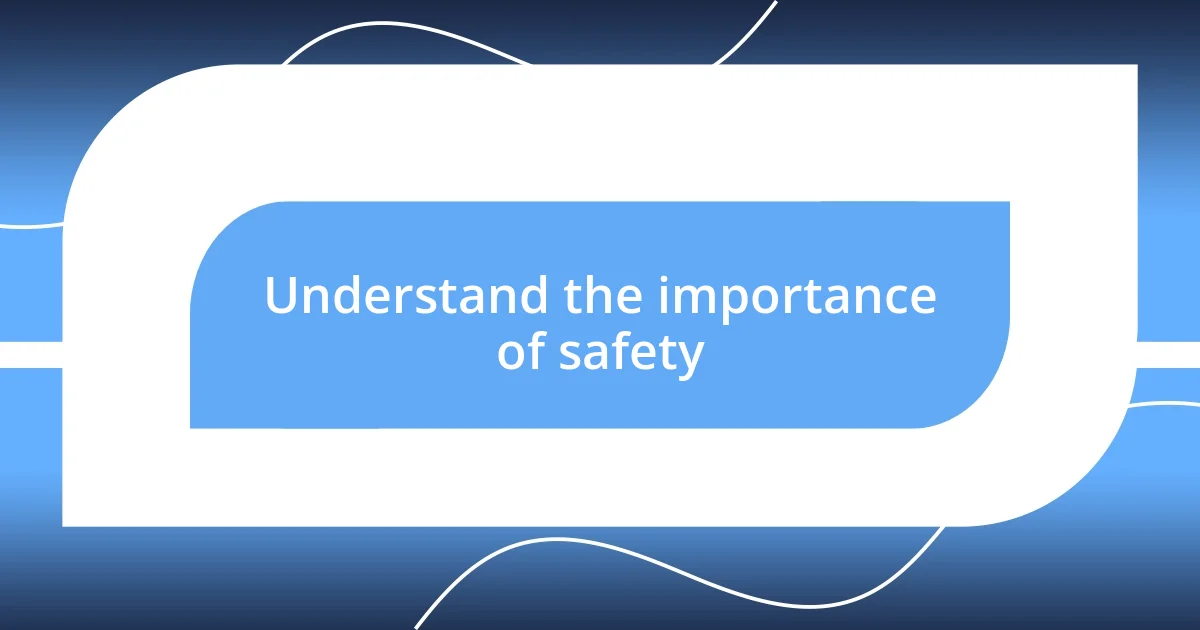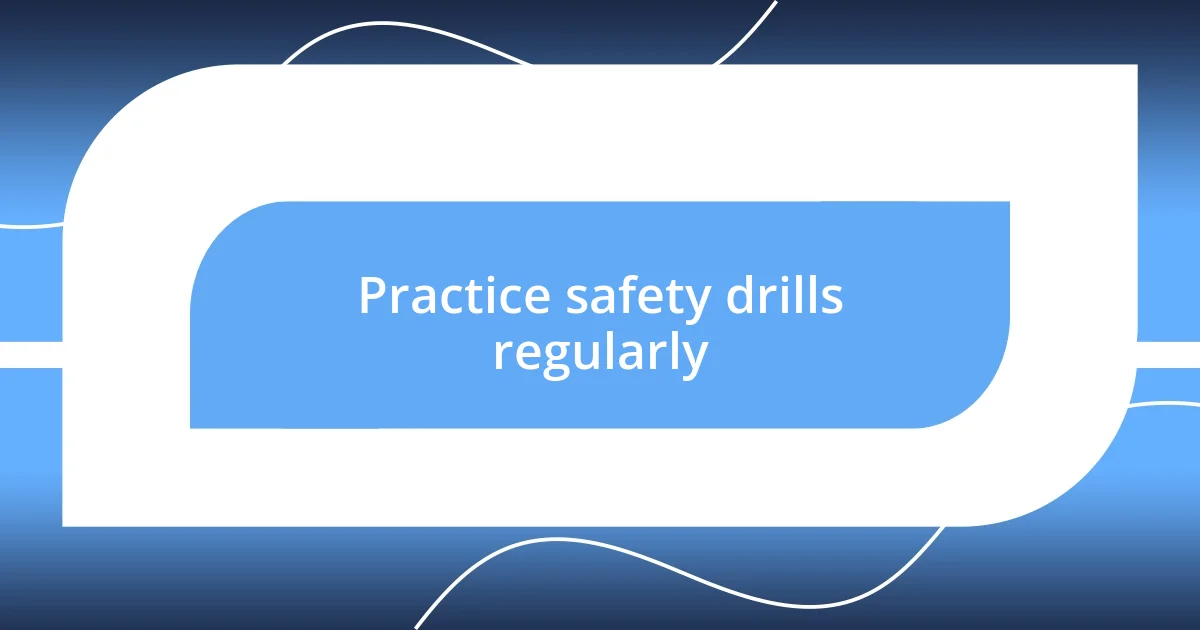Key takeaways:
- Recognize safety as a proactive mindset requiring constant awareness and preparation for potential risks at home, such as slipping hazards and child safety issues.
- Create a household safety team involving all family members to foster teamwork and responsibility, with assigned roles for effective safety management.
- Regularly practice safety drills and establish an emergency communication plan to build confidence and ensure everyone knows how to respond during a crisis.

Understand the importance of safety
Safety isn’t just a checklist; it’s a mindset that shapes how we live every day. I often think about the time when I had a small kitchen accident that could have turned serious if I hadn’t been cautious. Isn’t it comforting to know that taking proactive steps in our environment can prevent unforeseen risks?
I remember when I decided to childproof my home after a close friend had an incident where her toddler swallowed a small object. It hit me hard, realizing how easily things can go wrong. Isn’t it our responsibility to ensure our homes are sanctuaries of safety for those we love?
Understanding the importance of safety means recognizing that it’s about being prepared for emergencies before they happen. I find solace in having plans in place, knowing I’ve done my part to protect my family. What strategies do you think would work best for you?

Identify potential risks at home
Identifying potential risks at home is a critical first step in creating a robust safety plan. I distinctly recall a moment when I noticed my elderly neighbor struggling to maneuver around clutter in her living room. It made me realize how easily a simple trip hazard can lead to serious injuries. As I took time to evaluate my own space, I discovered several areas that could pose risks, often hidden in plain sight.
To give you a clearer picture, here are some common potential risks you might encounter at home:
- Slipping hazards: Rugs without non-slip backing, wet floors, and uneven surfaces.
- Fire risks: Overloaded electrical outlets, unattended candles, and outdated smoke detectors.
- Toxic substances: Cleaning products, medications, and other hazardous materials stored out of reach or in unmarked containers.
- Child safety: Sharp corners on furniture, small objects within reach, and access to electrical outlets.
- Emergency exits: Blocked pathways to doors or windows that could impede a quick escape during an emergency.
It’s fascinating how many dangers could lurk around us, often unnoticed until something happens. The more proactive we are in identifying these risks, the better equipped we become to create a safer environment for ourselves and our loved ones.

Create a household safety team
Creating a household safety team is an essential step in ensuring that everyone in your home can contribute to a safer environment. I recall gathering my family together one evening to discuss safety. It was illuminating to hear everyone’s concerns and suggestions; those conversations often lead to important adjustments. Did you know that involving family members in safety planning can boost their awareness and responsibility? It’s fascinating to see how each perspective adds value.
In my experience, assigning specific roles based on age and ability fosters teamwork. For instance, my youngest helps out by monitoring the layout of our living spaces, while my older kids handle more complex tasks, like checking smoke detectors and reviewing emergency contacts. This approach not only makes my kids feel included but also empowers them with knowledge and responsibility. Is it surprising how collaborative efforts can enhance safety at home?
Having a safety team also means regular meetings to review protocols and address new risks. Last month, we gathered to update our household safety plan after learning new fire safety tips from a neighbor. It was reassuring that everyone was on the same page and actively engaged in the process. Isn’t it comforting to know that when you bring everyone together, you create a culture of safety that everyone can buy into?
| Role | Responsibility |
|---|---|
| Team Leader | Oversees safety measures and coordinates efforts |
| First Aid Coordinator | Maintains first aid supplies and provides training |
| Emergency Contact Manager | Keeps an updated list of emergency contacts |
| Child Safety Monitor | Ensures child-proofing measures are effective |

Develop an emergency communication plan
Developing an emergency communication plan is one of the cornerstones of a solid safety strategy. I remember when a sudden storm hit while my family was out, and I felt a wave of panic thinking about how we would reconnect. Establishing a reliable way to communicate during emergencies can bring peace of mind, knowing that everyone has the information they need to stay safe. What methods do you think your family would find the easiest to use?
Consider creating a list of important contact numbers, including relatives, friends, and local emergency services. I still refer to the laminated card I made and placed on our fridge; it includes everyone’s phone numbers and a few essential addresses. Having that physical reminder in a known spot can save precious time in a crisis. Isn’t it comforting to know that you can quickly access critical information when it matters most?
Additionally, designating a specific meeting point outside your home can help streamline communication during an emergency. When I was a child, my parents chose a tree at the end of our street as our rallying point. It was an uncomplicated solution that offered a clear strategy. By discussing potential rendezvous locations with your loved ones, you can minimize confusion and anxiety during unexpected events. After all, isn’t the goal to alleviate stress and ensure, as a family, we can navigate challenges together?

Practice safety drills regularly
Practicing safety drills regularly is more than just a checkbox on your to-do list; it’s an opportunity to build confidence among family members. I recall the first time we conducted a fire drill at home. There was a moment of surprise followed by laughter as my youngest tried to declare our emergency evacuation route like he was giving a presentation. That shared experience made the importance of drills come alive, turning a potentially stressful situation into a bonding moment. How often do you think families overlook such vital practice sessions in the hustle and bustle of daily life?
Drills not only prepare us for emergencies but also refine our response times. I remember a particularly rainy day when we practiced our escape plan. As we dashed from room to room, I noticed my older kids were alert and taking charge, guiding their siblings and helping them remember our safety gear. It was enlightening to see them step into leadership roles; it confirmed how impactful regular practice can be. Have you ever considered how drills transform not just knowledge but also confidence and initiative in your loved ones?
Incorporating fun elements into your drills can make them feel less daunting. One time, we added a scavenger hunt twist to our emergency kit check. Each family member was tasked with finding specific items within a time limit. Not only did it help reinforce the importance of having supplies ready, but it also turned a routine check into a lively competition. How could you make your safety drills more engaging and enjoyable for your family? By incorporating a bit of creativity, you’re not just training for emergencies; you’re also creating memorable moments that solidify the importance of safety in your home.














